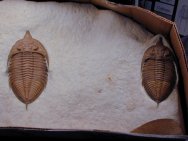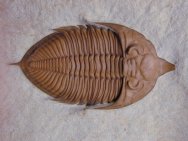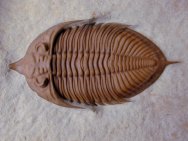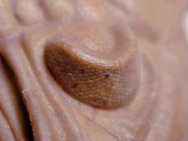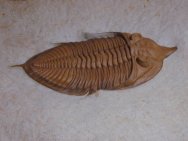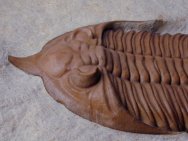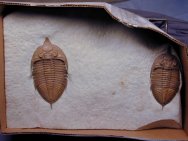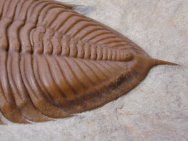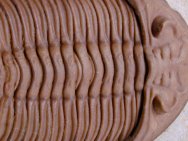Huntoniatonia
(Huntonia) huntonensis
Trilobite
Order
Phacopida, Suborder Phacopina, Superfamily Dalmanitoidea, Family Dalmanitidae
Geological
Time: Lower Devonian
Size: (25.4
mm = 1 inch):
Fossil
Site: Haragan Formation, Coal County, Clarita, Oklahoma
| 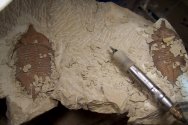 Description:
Huntoniatonis ( Huntonia) huntonensis is a Dalmanatid trilobite
(Order: Phacopida; Suborder Phacopina; Superfamily: Dalmanitoidea;
Family: Dalmanitidae) coming from the Lower Devonian strata of Coal
County, Oklahoma. While the name seems like a typo, it is the result
of the fact that the original genus Huntonia was found to be preoccupied
by an Isopod. It is primarily distinguished from the more rare species
of genus Huntonia from Oklahoma by its shorter pygidial spine. This
trilobite was prepared by Bob Carroll, a world-renowned preparator
of Oklahoma Devonian trilobites. Others may use less care, resulting
in a less desirable specimen. Notice the may fine eye facets preserved
in this specimen. Bob was only able to locate and prepare a few
examples of these dramatic trilobites in the last year. Description:
Huntoniatonis ( Huntonia) huntonensis is a Dalmanatid trilobite
(Order: Phacopida; Suborder Phacopina; Superfamily: Dalmanitoidea;
Family: Dalmanitidae) coming from the Lower Devonian strata of Coal
County, Oklahoma. While the name seems like a typo, it is the result
of the fact that the original genus Huntonia was found to be preoccupied
by an Isopod. It is primarily distinguished from the more rare species
of genus Huntonia from Oklahoma by its shorter pygidial spine. This
trilobite was prepared by Bob Carroll, a world-renowned preparator
of Oklahoma Devonian trilobites. Others may use less care, resulting
in a less desirable specimen. Notice the may fine eye facets preserved
in this specimen. Bob was only able to locate and prepare a few
examples of these dramatic trilobites in the last year.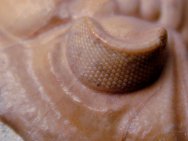
The
picture above left shows the trilobites at an early stage of
preparation. The pictures below show many aspects of Bob's finished
masterpiece, including the beautiful eyes.
Huntoniatonia
had Schizochroal eyes, which were a remarkable evolutionary achievement
that appeared exclusively in Phacopida suborder Phacopina. This
type of trilobite eye possessed an internal optical-doublet structure
together with a refracting interface (comprised of two lenses with
differing refraction so they would work together) that corrected
focusing. Human scientists would not accomplish the same optical
physics trickery until some 400 million years later -- who then
could possibly doubt the creativity of natural selection?
|
|


